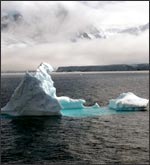
|
 |
 |

February 14, 2003
Back to "Civilization"
 |
An iceberg that Dan encounters displays brilliant shades of green and blue.
More Pictures |
I'm standing in the bridge of the
research vessel L.M. Gould, steaming home. There's only one chair here,
a bucket seat located exactly in the middle, for the mate, who operates the
ship. Anyone else who wants to sit has to be satisfied perching on a counter,
legs dangling down. Most visitors to the wheelhouse, as the bridge is called
here, find the view through the dozen or so picture windows too riveting to
stay seated for long anyway.
Before us we have four full days of travel. Its about 900 miles from Palmer
Station to Punta
Arenas and the ship only goes about ten miles an hour, no faster than a
sprinter. If you could pedal on water and didn't stop for sleep, you could beat
the 3,000 ton vessel on a bicycle (though you'd have trouble fitting all the
cargo in saddlebags). Fortunately, there are distractions. In the lounge there's
a large-screen TV and a decent collection of videos and DVDs, including some
recent releases. There are computer terminals for sending email and a foosball
set in the hold (a tournament was recently completed but the game is a perennial
pastime on the Gould).
Despite the length of the trip and the availability of diversions, I spend most of my time sightseeing from the wheelhouse. I lean against the blond-wood window sill on the starboard side and scan the sparkling water with a pair of binoculars. Then I cross the room and continue watching from the port. The first day animal life and strangely sculptured icebergs are plentiful. Seals nap serenely on floes, apparently uninterested in our presence. There's a big black rock sitting on one iceberg. I wonder how it got there. A pod of several humpback whales intersects our path and briefly trails the ship. Another pod of humpbacks breaches, something I've never seen before. Off our starboard side, they shoot straight up out of the water until they appear completely suspended in the air. Then, they crash down on their backs with a huge splash. Why a 40 foot animal weighing upwards of 25 tons would leap into the air is almost beyond comprehension, though they appear to be having a good time.
As the sun sets we approach the Drake Passage, passing the last land we'll see for two days. The swell picks up and the ship begins to rock, but fortunately the barometer is rising and our crossing is blessed with good weather. Sea birds accompany us much of the way, including a huge shimmering white wandering albatross with wings that could be eleven feet from tip to tip. The majestic glider dips and climbs just above the waves, hardly ever flapping its huge wings.
On the third day we sight land again, steam around the perimeter of Tierra del Fuego and enter the Strait of Magellan. "Civilization" makes its appearance in the form of dozens of oil rigs, some spouting flames, between the shores lining this famous waterway. Jim From, a mate who has spent years tending oil rigs with special tugs, says the world's most productive offshore well is somewhere nearby. A Chilean pilot joins the ship near midnight on the final leg of our journey. He takes charge of the boat until sunrise, when we arrive once more at Punta Arenas.
It's been five weeks since I've seen a road, a car, a restaurant or even a new
face. Before the onslaught of family life, chores and all news all the time
envelops me, I wonder what I've learned at the bottom of the Earth. Despite
a new communications system at Palmer Station, making phone calls cheap and
easy and permitting the internet pipeline to pour into the Antarctic, the research
base is strangely cut off from the outside. Condensed editions of the Christian
Science Monitor and a news digest called the Daily Snooze circulate in the
dining lounge, but they generate less interest than the New
York Times crossword puzzle. I, too, have ignored the news and I wonder
what I've missed. While my friends have been transfixed by urgent reports of
war and disasters, I've been steeped in details of the diet of giant petrels
and the breeding habits of Adelie penguins. Penguin researcher Bill
Fraser thinks he's found a link between global warming and a 30-year decline
in Adelies. If he's right, he may have discovered the most conclusive proof
so far that climate change could sever threads in the food webs that link living
things around the world together. Thirty years from now, what passes for news
today may appear to be a footnote compared to these results.
Read the February 10th entry
Read the February 6th entry
Read the February 5th entry
Read the January 31st entry
Read the January 27th entry
Read the January 22nd entry
Read the January 17th entry
Read the January 14th entry
Read the January 13th entry
Read the January 9th entry
Read the December 29th entry
Read the December 23rd entry
|
|



